Isis in Central America ©

The Genesis of Isis went everywhere.
The Temple of Isis spread enlightenment to the whole world in a Golden Age before the dawn of monotheism.
The Temple of Isis had missionaries all over the world in ancient times. It wasn't necessarily called "Temple of Isis" in all the cultures that adopted that religion. While some of her missionaries were teaching the arts of civilization to the known world, others were out exploring the rest of the world. Pagan religion and genealogy were more widespread in the ancient world than Christianity is now.
The religions and cultures of pre-Columbian Central American civilizations were intimately related to the Pagan religion and culture of Egypt. Spanish priests identified the Mayas, Aztecs, and Incas as "Pagans." They burned their books along with any literate people and teachers who were the readers and keepers of the books. Those Spanish priests who identified Mesoamerican Indians as Pagans were correct. The "isolationist" scholars of today who deny pre-Columbian contact between the Americas and Mediterranean civilizations are in deep denial. All of the evidence is clearly there for anyone who wishes to see it. None are so blind as those who choose not to see.
According to the Pagan foundation legend, Assur was the first king of the first kingdom on earth. Isis resurrected Assur from the dead. A great world wide religion grew out of the resurrection of Assur. Isis had union with her resurrected king. Their son, Heru was born of the union of Isis and Assur. The royal bloodlines of divine kings the world over sprung from the ancestry of Isis and Heru. That was the Genesis of Isis.
According to the foundation legend, Assur raised his own people up from savagery. After he raised his own people up out of ignorance and savagery, he went about teaching the arts of civilization to the "whole world." Assur's legendary travels carried the Genesis of Isis all over the world. It is well to bear in mind that those missionary travels of Assur were going on AFTER Isis resurrected him from the dead. That is to say, those travels of Assur were minions of ISIS carrying the arts of civilization to the rest of the world. When they had gone as far west as they could go on foot, they took to the sea.
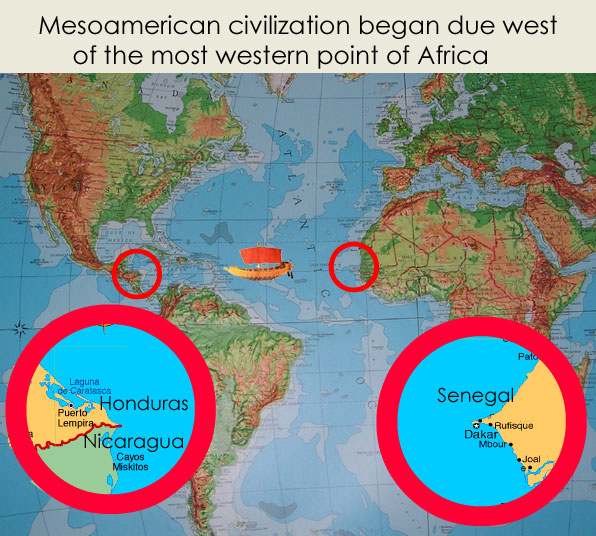
The minions of Isis who carried the arts of civilization to the rest of the world were bearded UrReans.
The UrReans were followers of hawk god/sun god religion. (See the Sunwing page on this web site for a descriptive discussion of who were the UrReans.)
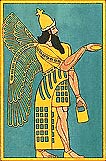
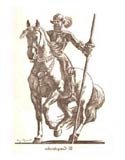
The original Assur and his descendants were UrReans. The minions of Isis who went out exploring the world were UrReans. They went out as explorers, visitors, and teachers carrying the arts of civilization. They weren't conquistadors, gold hunters, and religious zealots as were later waves of Europeans. The UrReans were very hairy folks. They had tremendous beards and a lot of body hair. Those heavily bearded UrReans and their teachings had lasting effects on the cultures and languages of the peoples they visited.
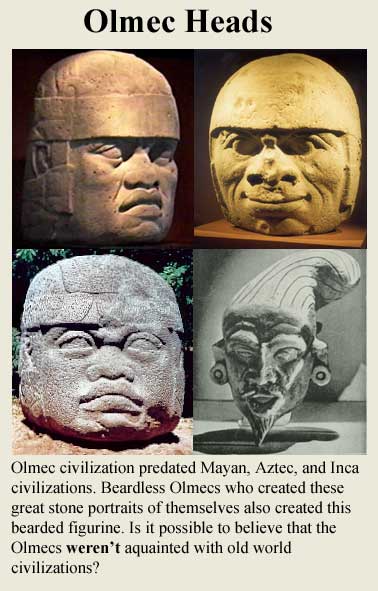
"The earliest civilization in Central America—and possibly the earliest civilization in the Americas—was the Olmec civilization which arose sometime between 1200 and 1000 BC. They originally lived in the Gulf Coast region of southern Mexico, but soon expanded into Guatemala. . ."
"The most dramatic achievement of the Olmecs was the building of massive stone heads. We aren't sure who is represented by these heads, but archaeologists believe that they may be Olmec kings. . ."
"Around 300 BC, the Olmec vanished for reasons that vanished with them. We do know, however, that much of their culture and social structure was absorbed by other peoples. The Olmecs, as far as we can tell, are the first chain in the development of Mesoamerican culture."
(Richard Hooker, Washington State University)
"The Olmec were Mesoamerica's first civilization. They were
located in Laguna de los Cerros, tres Zapotes, San Lorenzo, La Venta,
and the Tuxtla Mountains, in Mexico. . ."
"The Olmec were a mother culture to later civilizations. The
culture of the Olmec started in Mexico's Gulf Coast between 1200 and
1400 B.C , approximately between the Trojan War, and the golden age of
Athens, and ended about 3000 years ago. . . Perhaps the most spectacular trait of the Olmec
were that they used hieroglyphs. They used hieroglyphs to record
dates, events, and to tell stories." George E. Stuart, New Light on the Olmec, National Geographic Nov. 1993
Itzamna, ancestral deity of the Itza-Maya culture or civilization..
"Itzamna is said to have come in his boat across the eastern waters. One of his titles was Kakin-Chan, 'serpent of the East.' . . . "
"He is said to have been the founder of the culture of the Itza-Maya. He was the first priest of their religion; invented writing and books. He named all of the localities in Yucatan and divided the land among the people. As a physician he was famous, not only knowing the magic herbs but possessed the power of healing by the laying on of hands, whence came his name Kabul, the Skillful Hand . . ."
"He came from the direction of the rising sun and was not alone. He brought with him the captains and followers who became the builders of the first ruined cities of the Yucatan peninsula."
(T.A. Willard in Kukulcan, the Bearded Conqueror, quoting Daniel H. Brinton, 1941)
As the inventor of writing and books, Itzamna was, by extension, creator of the calendar and chronology.
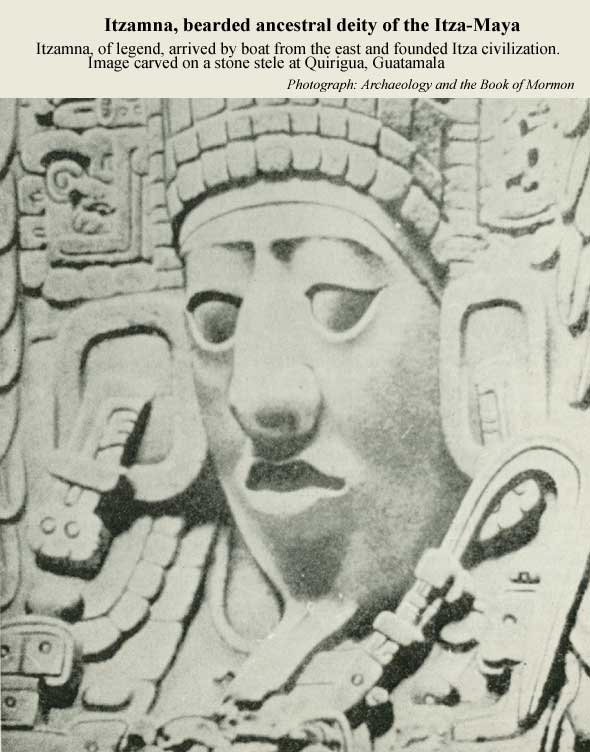
This is the finest sculptured face yet found in the Maya area, which some claim represents Itzamna. This face has an Egyptian appearance. The pendant beard is strikingly like those shown on the sculptured faces of the Pharaohs of Egypt. The stela on which this face appears was found in the southern area, or what is termed the Old Empire.
The Itza-Maya were one of various semi-independent tribes of Mayas. Chichen Itza was their main religious and cultural center. It seems that Chichen Itza went through a number of declines or "crashes" that may even have left the city deserted. Chichen Itza recovered from one such decline under Toltec influence. Toltec images of Itzamna frequently depict him as an old man with a few jagged teeth and no beard. However, that "toothless old man" imagery may symbolically represent an old and feeble dynasty that decayed and fell. Later images of the bearded Toltec deity, Kukulcan, may represent a religious renaissance, or a new invigorated ruling dynasty. The Itza-Maya may have brought Toltecs into their genealogy to reinvigorate their royal bloodline. Some people believe that this bearded image represents Itzamna in his prime. It was found outside of the Toltec area of influence.
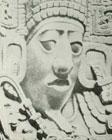
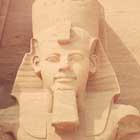
Note the stylized beard of Itzamna and its similarity to the stylized beard of Pharaoh Rameses II. Rameses II was Pharaoh of Egypt at about the time of Itzamna's arrival in Central America and the dawn of the earliest civilizations there. Rameses II, son of Seti I and Queen Tuya, was the third king of the 19th Dynasty. He lived to be 96 years old. He reigned as Pharaoh for 67 years (1279-1213 BC).
Itzamna's Arrival.

The image to the left is Itzamna arriving from the east paddling a canoe (c. 1200 BC). The image to the right is the galleon of Rameses III (c. 1175 BC). The Maya used canoes. They didn't have ships. Notice the row of "wings" along the side of the canoe that Itzamna is paddling. The Mayan artist who made this image had almost certainly never seen a ship. The artist was probably working from a verbal description of a "canoe" with rows of oars along the sides and sails that enabled it to "fly" before the wind.
The bearded god, Kukulcan, of Chichen Itza probably represents a later "incarnation" of Itzamna.
Kukulcan was "The Maya supreme god, to whom the Maya attributed many functions. Not only was he a god of the four elements, he was also a creator god and the god of resurrection and reincarnation. He originated from Toltec myth, where he was a divine hero who taught the Toltecs laws, fishing, healing, the calendar, and agriculture. He emerged from the ocean, and disappeared in it afterwards." (Mica F. Lindeman in Encyclopedia Mythica, 2002)

The biographical sketch of Kukulcan from the Encyclopedia Mythica matches very well the story of Itzamna. Both stories match very well the legend of Assur as written down by Herodotus, Diodorus, Plutarch and others.
Pagan religion was "ancestor worship" religion. The original ancestors were Assur, Isis, and Heru. Pagan religion over the world was not as uniform as is Christianity or Buddhism. Different cultures around the world had different ancestors and different cultural traditions before they came into contact with Pagan culture and genealogy. Different cultures around the world continued to have different ancestors and different cultural traditions after they came into contact with Pagan culture and genealogy. Nevertheless, they were Pagan descendants of the Genesis of Isis.
Pagan religion made no distinction between genealogy, religion, and politics. Paganism was an ancestral religion that was the basis of political power, and political power originated from genealogy. However, genealogy diffuses over time and is no match for military might. Through conquests, merging civilizations, changing languages, and changing dynasties, the ancestral pantheons of ancient cultures were ever branching and growing. They are often very confusing.
Itzamna, Kukulcan, and Quetzalcoatl were all bearded "Plumed Serpent" ancestral deities. They all shared the common Egyptian Pagan ancestry of bearded Assur, Isis, the "Serpent Goddess," and Heru, the "Hawk God."
Another youthful Itzamna?.
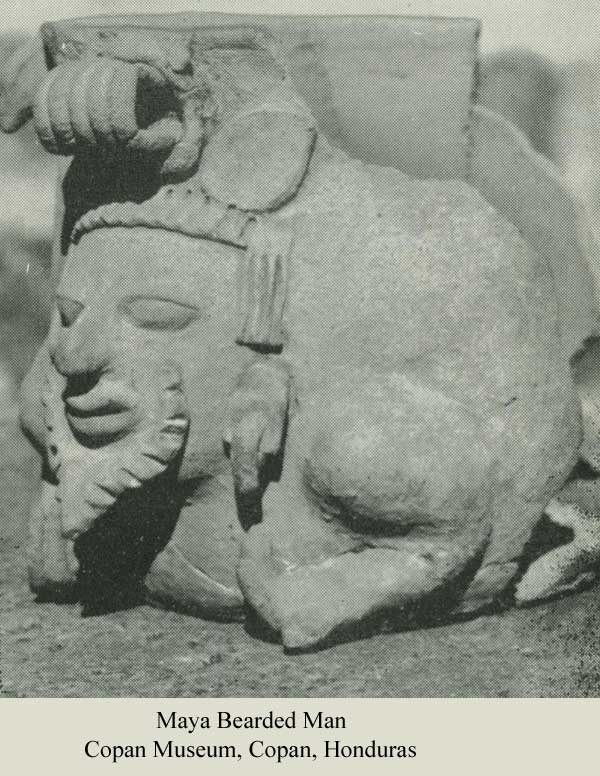
This vase with the bearded face is from the Mayan "Old Empire" (c.430 AD). This Mayan figure from Honduras may be Itzamna in his youth. It could be Itzamna by a different name. Or it could be a different ancestor altogether. The Maya were divided into numerous tribes who spoke different languages. They all shared some common ancestors, while at the same time they had different ancestors. The different names of their deities may represent different entities, or they may represent the same entities by different names. Despite their different genealogies, different languages, and different cultures, the pre-Columbian civilizations of Central America shared a common bearded plumed serpent deity now most commonly known as "Quetzalcoatl."
Quetzalcoatl, the "Plumed Serpent" god..
The "quetzal" is a fabulous plumed bird of the Central American highlands, also known as the "Bird of Paradise." Its plumage was highly valued in Central American cultures. Its plumage may have been reserved exclusively for the adornment of royalty. The great plumed headdresses of Mesoamerican rulers and dignitaries represented accumulations of great wealth. "Coatl" is a word for serpent. Together, they add up to a winged serpent "dragon" symbol of the same genealogy of other dragons around the world.
Heru was the "Hawk God." Isis was the "Serpent Goddess." The Genesis of Isis went everywhere. Winged serpent dragon imagery from all over the world originates in the Pagan ancestral religion of Isis and Heru.
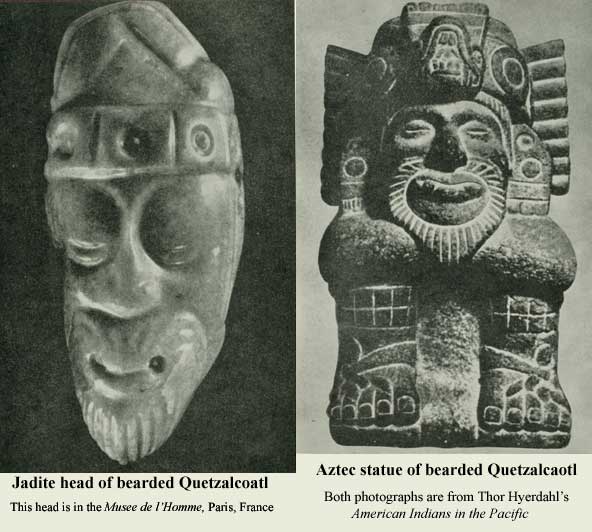

Lifelike visage of bearded Olmec deity or ancestor..
"The Olmecs, as far as we can tell, are the first chain in the development of Mesoamerican culture."
(Richard Hooker, Washington State University, 1996)
"The Olmec were a mother culture to later civilizations. The
culture of the Olmec started in Mexico's Gulf Coast between 1200 and
1400 B.C , approximately between the Trojan War, and the golden age of
Athens, and ended about 3000 years ago. . . "
(George E. Stuart, New Light on the Olmec, National Geographic Nov. 1993)
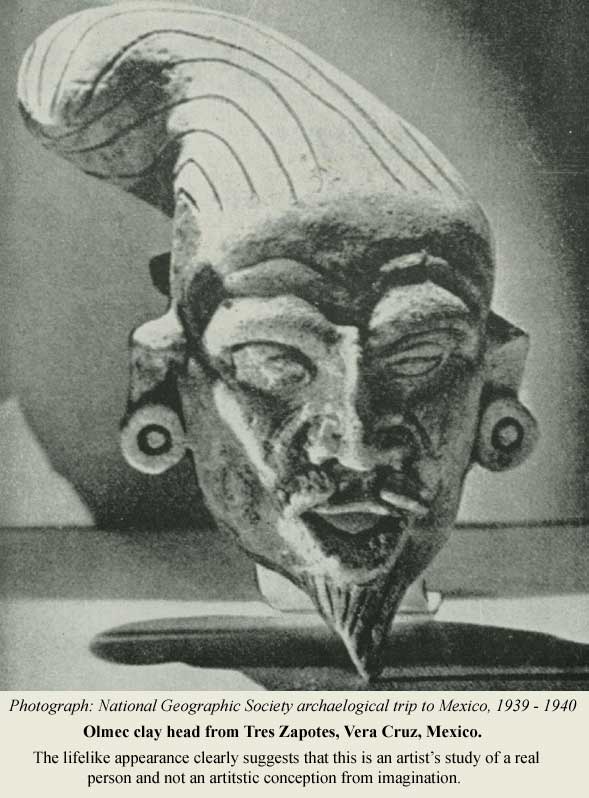
"The Olmec were the mother culture of later civilizations." This Olmec figurine was clearly modeled from a living human being. Similar bearded figures from other Mesoamerican civilizations could be later day copies of earlier artifacts. The later day Aztec and Inca visages of Quetzalcoatl and Kon Tiki are never as clearly lifelike as is this visage of a visitor who arrived on Olmec shores from the east.
Then came the Conquistadors!
". . . in the beginning the Indians regarded the Spaniards as angels from heaven."
(Bartolomé De Las Casas, The Devastation of the Indies, 1552)
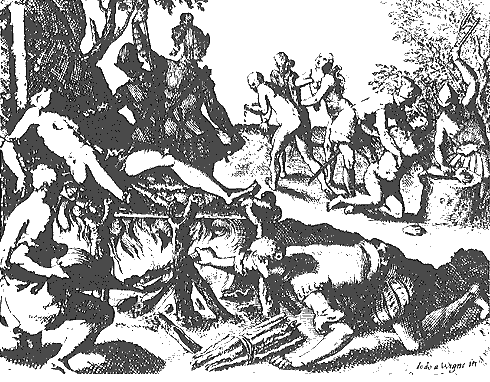
"With my own eyes I saw Spaniards cut off the nose, hands and ears of Indians, male and female, without provocation, merely because it pleased them to do it. ... Likewise, I saw how they summoned the caciques and the chief rulers to come, assuring them safety, and when they peacefully came, they were taken captive and burned."
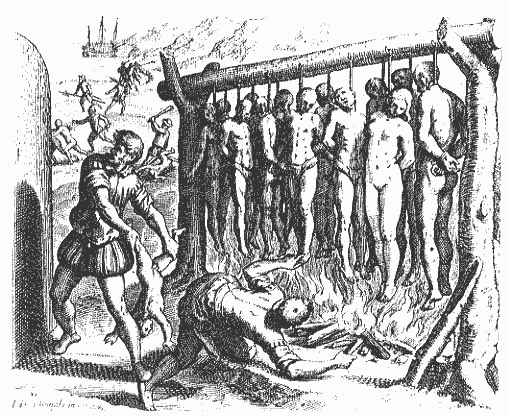
"[The Spaniards] took babies from their mothers' breasts, grabbing them by the feet and smashing their heads against rocks. ... They built a long gibbet, low enough for the toes to touch the ground and prevent strangling, and hanged thirteen [natives] at a time in honor of Christ Our Savior and the twelve Apostles. ...Then, straw was wrapped around their torn bodies and they were burned alive."
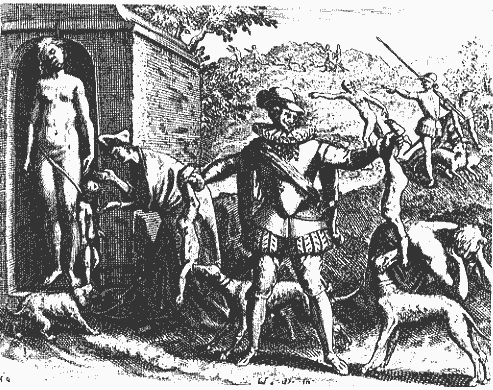
"As the Spaniards went with their war dogs hunting down Indian men and women, it happened that a sick Indian woman who could not escape from the dogs, sought to avoid being torn apart by them, in this fashion: she took a cord and tied her year-old child to her leg, and then she hanged herself from a beam. But the dogs came and tore the child apart; before the creature expired, however, a friar baptized it."
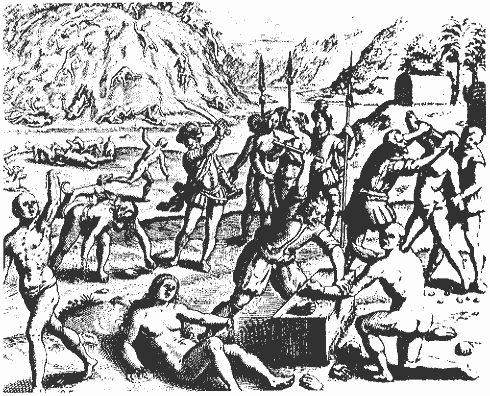
"They would cut an Indian's hands and leave them dangling by a shred of skin ... [and] they would test their swords and their manly strength on captured Indians and place bets on the slicing off of heads or cutting of bodies in half with one blow. ... [One] cruel captain traveled over many leagues, capturing all the Indians he could find. Since the Indians would not tell him who their new lord was, he cut off the hands of some and threw others to the dogs, and thus they were torn to pieces."
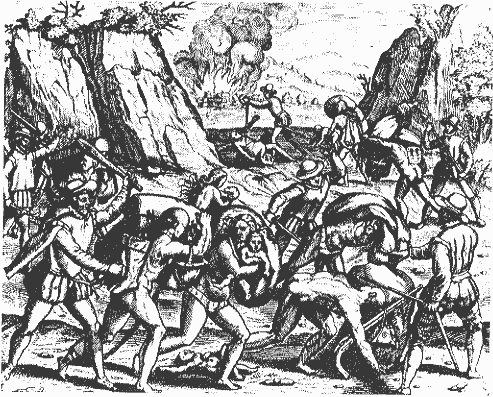
"The Spanish treated the Indians with such rigor and inhumanity that they seemed the very ministers of Hell, driving them day and night with beatings, kicks, lashes and blows, and calling them no sweeter names than dogs. ... Women who had just given birth were forced to carry burdens for the Christians and thus could not carry infants because of the hard work and weakness of hunger. Infinite numbers of these were cast aside on the road and thus perished."
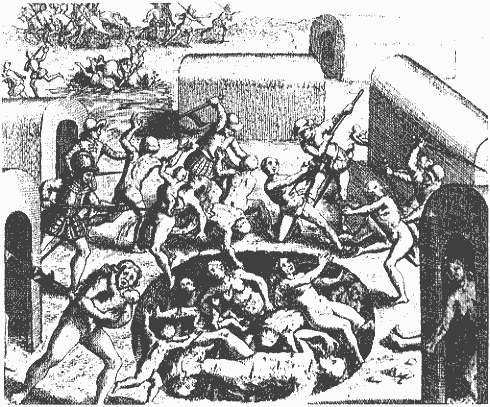
"They threw into those holes all the Indians they could capture of every age and kind. ... Pregnant and confined women, children, old men [were] left stuck on the stakes, until the pits were filled. ... The rest they killed with lances and daggers and threw them to their war dogs who tore them up and devoured them."
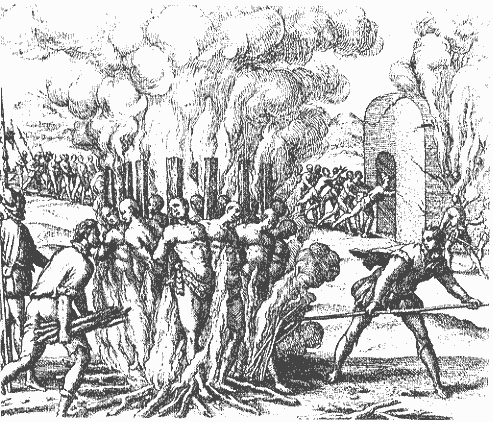
"Because he did not give the great quantity of gold asked for, they burned him and a number of other nobles and caciques... with the intention of leaving no prince or chieftain alive in the entire country."
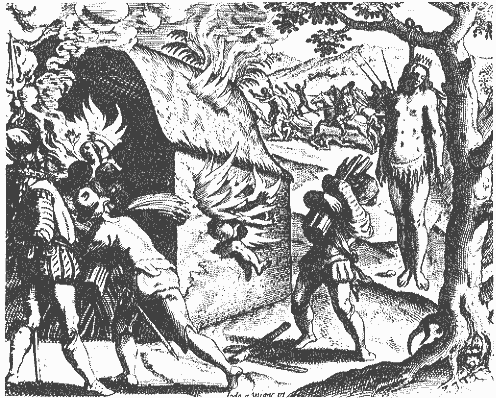
"When the Spaniards had collected a great deal of gold from the Indians, they shut them up in three big houses, crowding in as many as they could, then set fire to the houses, burning alive all that were in them, yet those Indians had given no cause nor made any resistance."
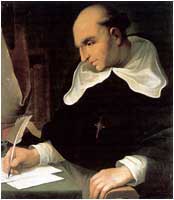
These descriptions of Christian behavior in Central America are eye witness accounts of Don Frey Bartolomé De Las Casas (1552). Frey De Las Casas, was a Catholic priest who was appalled at the behavior of his countrymen in the "Indian lands of the west." He wrote books and numerous letters pleading for fairer treatment of the "Indians" and denouncing the atrocities he witnessed being inflicted upon them.
Bartolomé De Las Casas began his career in America as a soldier and encomendero. He sailed to the "Indies" with Nicolas de Ovando's fleet in 1502. He returned to Europe where he was ordained a deacon in Rome. In 1512, he was the first Catholic priest to be ordained in the new world. He served as a chaplain in the armies of Diego de Valesquez and Panfilo de Narvaz in their conquest of Cuba. He was awarded lands and slaves for his service. As a land owning, slave owning, encomendero he had a spiritual awakening. He freed his slaves and began to campaign for the abolition of slavery and repatriation of the Indians. His critics accused him of treason.
(References)
Bartolomé De Las Casas, The Devastation of the Indies, (Original publication 1552) Johns Hopkins University Press, Baltimore & London, 1992.
Bartolomé De Las Casas, History of the Indies, translated by Andrée M. Collard, Harper & Row Publishers, New York, 1971
Bartolomé De Las Casas, In Defense of the Indians, , translated by Stafford Poole, C.M., Northern Illinois University, 1974.
John Grier Varner & Jeannette Johnson Verner, Dogs of the Conquest, University of Oklahoma Press, Norman OK, 1983.
Kon Tiki
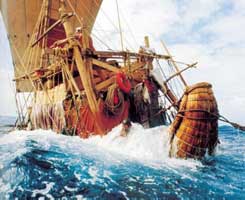
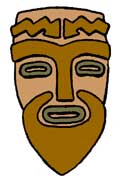 Thor Hyerdahl crossed the Pacific Ocean in 1947 on a balsa raft named "Kon Tiki." The Kon Tiki was named after a bearded Peruvian ancestral deity. In 1970, Heyerdahl crossed the Atlantic Ocean on a reed boat to prove that a pre-Columbian connection between Mediterranean and Mesoamerican civilizations was possible. Ancient reed boats were virtually unsinkable. Even if they broke completely apart in bad weather, they would continue to float. They could only sink if the reeds became completely waterlogged, which would take a long time.
Thor Hyerdahl crossed the Pacific Ocean in 1947 on a balsa raft named "Kon Tiki." The Kon Tiki was named after a bearded Peruvian ancestral deity. In 1970, Heyerdahl crossed the Atlantic Ocean on a reed boat to prove that a pre-Columbian connection between Mediterranean and Mesoamerican civilizations was possible. Ancient reed boats were virtually unsinkable. Even if they broke completely apart in bad weather, they would continue to float. They could only sink if the reeds became completely waterlogged, which would take a long time.
 Hyerdahl's trips on rafts and reed boats weren't really necessary to make his point. People have been sailing the seas in boats with sails and rows of oars as long as they have been riding horses. Queen Hatshepsut, the "female Pharaoh" of the 18th Dynasty, reigned from 1504 to 1482 BC. In the summer of 1493 BC, she sent a fleet of five ships with thirty rowers each from Kosseir, on the Red Sea, to the Land of Punt, near present-day Somalia. A beautiful and detailed Mural of one of her ships adorns a wall of her temple at Deir el-Bahri, Egypt. That was not Egypt's first sea venture. Hatshepsut was resuming trade relations that had been interrupted in earlier dynasties. Hatshepsut was a descendant "daughter"/priestess of Isis. The earliest Mesoamerican civilizations arose centuries after Hatshepsut's reign.
Hyerdahl's trips on rafts and reed boats weren't really necessary to make his point. People have been sailing the seas in boats with sails and rows of oars as long as they have been riding horses. Queen Hatshepsut, the "female Pharaoh" of the 18th Dynasty, reigned from 1504 to 1482 BC. In the summer of 1493 BC, she sent a fleet of five ships with thirty rowers each from Kosseir, on the Red Sea, to the Land of Punt, near present-day Somalia. A beautiful and detailed Mural of one of her ships adorns a wall of her temple at Deir el-Bahri, Egypt. That was not Egypt's first sea venture. Hatshepsut was resuming trade relations that had been interrupted in earlier dynasties. Hatshepsut was a descendant "daughter"/priestess of Isis. The earliest Mesoamerican civilizations arose centuries after Hatshepsut's reign.
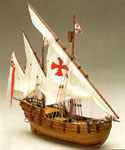
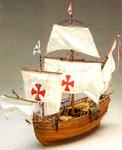 Columbus' ships, the Nina and the Pinta were no greater ships than Hatshepsut's. The Nina and Pinta were small ships. Carla Rahn Philips, puts the length of the Niña at 15 meters. She puts the length of the Pinta at 17 meters. The total crew aboard the Pinta was twenty-six people. That included the owner of the ship, the captain, a master, a pilot, a steward, a cabin boy, and a hold loaded with live chickens, pigs, and cattle in addition to water barrels and provisions. The cattle had to be slung in slings to keep them from falling or crashing about in heavy seas. They didn't have room for thirty rowers! Twenty people sailed aboard the Nina.
Columbus' ships, the Nina and the Pinta were no greater ships than Hatshepsut's. The Nina and Pinta were small ships. Carla Rahn Philips, puts the length of the Niña at 15 meters. She puts the length of the Pinta at 17 meters. The total crew aboard the Pinta was twenty-six people. That included the owner of the ship, the captain, a master, a pilot, a steward, a cabin boy, and a hold loaded with live chickens, pigs, and cattle in addition to water barrels and provisions. The cattle had to be slung in slings to keep them from falling or crashing about in heavy seas. They didn't have room for thirty rowers! Twenty people sailed aboard the Nina.
The ships of Columbus' time were "high tech" compared to the ships of tree thousand years earlier. They carried more sails and were more efficient at sailing. They didn't require labor to row them. The ships of Queen Hatshepsut's time were primarily muscle powered row boats that carried auxiliary sails to supplement the available human power. The ships of Columbus' time were purely wind powered sailing ships that may have carried oars, but only for emergency use. The rowed ships of earlier times that carried auxiliary sails were OK for sailing downwind. They couldn't travel upwind without muscle power. They were capable of ocean crossings, but not efficiently. The Niña and the Pinta were "caravels." Their superior rigging enabled them to sail upwind on wind power alone. The Niña was the best of the three ships at tacking upwind.
Native American art and religion clearly connects Mesoamerican native cultures to the Pagan cultures of Egypt and the "old world" UrRean civilizations.
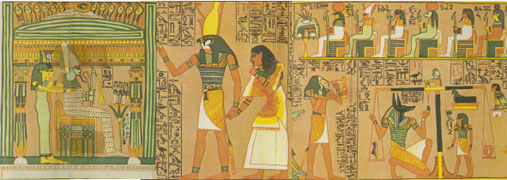
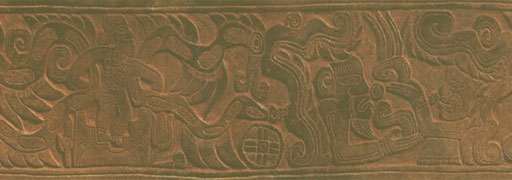
This carved wall panel from a Mayan temple in Central America is a Mayan version of the classical Egyptian Judgment Scene. They contain common elements.
Hawk, serpent, and sun symbolism were common to Pagan religion of Isis genealogy everywhere.
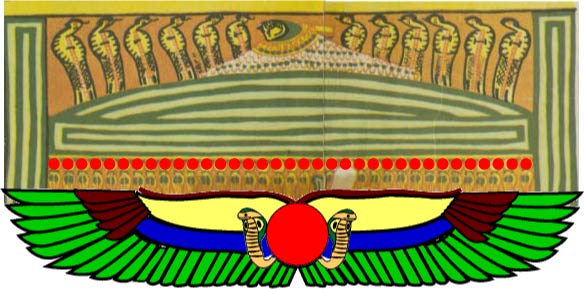
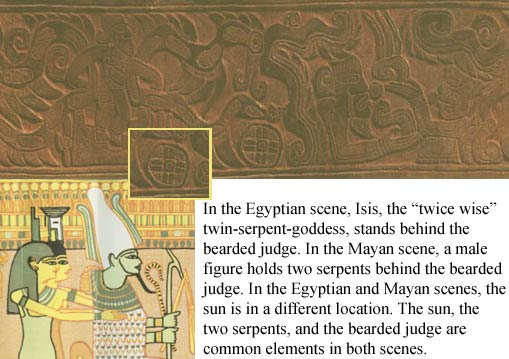
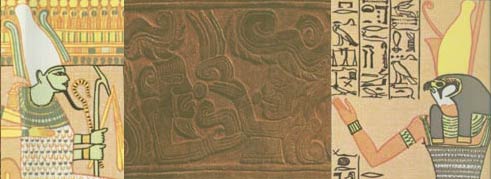
The bearded judge and the arm of a supplicant are nearly a perfect match in both scenes.
In the Egyptian Judgment Scene, Isis, the "twice-wise" serpent goddess is behind the judge. In the Mayan scene, the figure behind the judge is holding two plumed serpents. In the Egyptian scene, Heru is pleading the case of a bearded Egyptian before Assur. In the Mayan Judgment Scene, a beardless Mayan is pleading his case before a bearded judge. The Mayans were beardless people who traced their religious origins to bearded gods.
The "plumed serpent god" Quetzalcoatl was an American dragon of the Heru and Isis family of dragons.
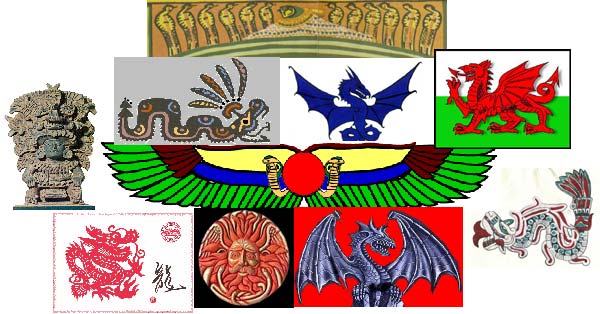
Heru was the Hawk God, Isis was the Serpent Goddess. Hawk and serpent symbolism in the form of winged serpent "dragons" spread over the world with the Genesis of Isis. Heru, the hawk god, and Isis, the serpent goddess, were the main forces in the Pagan religion. Assur was their 'founding father' ancestor, but he was a dead ancestor. The mother and the son were the active forces. Isis was "twice-wise." She was the goddess of double-wisdom. Her double-wisdom symbol was the serpent; and frequently her symbol was two serpents. Heru was the god of wisdom-in-action. His symbol was the hawk. The hawk god and serpent goddess together are the source of the winged serpent dragon symbols seen in cultural art from all over the world.
The name Assur is a compound of the names of the mother and the son, Isis and Heru. The name Isis is composed of Hiss Hiss, two hisses of the Sacred Asp of Isis. The name Heru is derived from the Ur sound of hawk's wings. The name Assur is composed of Hiss+Ur, the hiss of the asp + the whirr of hawk's wings. Hiss+Ur is the dragon sound. Assur is the dragon's name. Chinese dragons, Celtic dragons, Siamese dragons, and American dragons were all descendants of the original UrRean dragon, Assur.
(See the Alphabet S page on this website for more about dragons.)
The Genesis of Isis went everywhere. In the 3000 years after her birth, minions of Isis carried her enlightenment and her genes to all parts of the earth.
Resurrect Isis. There was a WorldFamily of EarthMother's children living in peace in a Golden Age in the past. Let us have a Golden Age civilization based on love, wisdom, and cooperation living in peace in the future.
|
Reader responses are invited. |
Return to Home Page . . . Return to Table of Contents Hub
Links to related topic pages:
Isis in North America . . . Sunwing . . .
Alphabet Page S . . . Alphabet Page V . . . Alphabet Page X